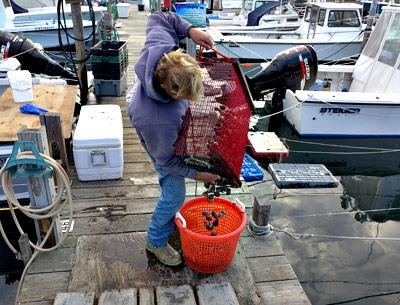The Action Is Close to Shore

There is so much we don’t know about the natural world, which, in many ways, is a good thing. Nothing wrong with a little mystery or sense of wonder.
Take the unusually bright fall colors on the East End this year. I suspect it has to do with the equally unusual absence of a strong northeast storm or brush by a passing hurricane to salt the trees and turn them brown.
And take the early appearance of scoters, sea ducks, hanging out in large rafts, chasing each other, and cooing not far from shore. Could it be that our lack of storms has allowed mussel beds and bottom vegetation to flourish? Has this drawn the sand eels and other prey species? Could the lack of storms be the reason striped bass on their western migration have been cruising close to shore, within casting distance, along the south-facing beaches of Napeague, Amagansett, East Hampton, and beyond?
Throughout the past week, the surfcasting has been exceptionally good along the sand beaches. Caravans of beach mobiles have followed the schools with the tide. Casters have reeled striped bass ashore in the 10-to-20-pound range with regularity despite the warning of last week’s naysayers who insisted, “It’s over.” And the fish have been eating well.
Fred Kalkstein, an organizer of the ongoing Montauk SurfMasters tournament, reported what he witnessed on Sunday:
“A week ago the schools stopped to feed at Napeague. Sunday afternoon, about 4 o’clock, right at Napeague State Park I see a lot of trucks. Forty or 50 to my right, 20 to 30 to my left. They were fishing bucktails and metals. A guy would bring in a fish that would normally weigh 15 pounds and it probably weighed 18 or 20. They were fat, looked like footballs.”
The fast and furious fishing has resulted in quick changes on the SurfMaster’s leader board. The action is particularly hot in the women’s and youth divisions. In recent days, Mary Ellen Kane caught a 19-pound bass and quickly topped that with one weighing 21.6 pounds. Christine Schnell, last season’s top female competitor, wrestled in a bass weighing 19.12 pounds. Griffin Kim, fishing in the youth division, nailed an 18.3-pound bass, but his brother James Jr. bested him with a 19.12-pounder, and shortly after that, Brandon Farrell topped the board with a 23.04-pound striper caught on the rod he won in the spring SurfMaster tourney.
By contrast, there were no changes in the wader and wetsuit divisions, although the laugh of the week came at the expense of the wetsuiter John Bruno who was chased from his rock perch by seals.
And what part are bunker, herring, and other large prey playing in all this? Starting last spring, large schools of bunker were seen in Fort Pond Bay. Are the oily fish back because the harvest of the Omega Protein Company of Virginia, the only menhaden fishing firm left, has been reduced by the federal government? But if the striped bass are feeding on bunker or other large prey, where are the gannets?
The spectacular diving birds with black-tipped white wings, blue, dagger-like bills, and the ability to swim deep after their prey, have been relatively scarce this season. The answer, according to Chris Miller of the West Lake Marina, is that bunker are not showing up. “I didn’t see many peanut bunker [menhaden fry] this summer at all. Sand eels are here and in a big way. I swam through shoals of them. It was like I was in bait balls,” he said, referring to the spherical swarms small fish form to make the school look like something bigger in order to fend off predators. Miller is an experienced free diver with a poetic flare. He described one dive during which he swam to the bottom and looked up to observe “a beautiful vision, a ceiling of sparkling white bait.”
If sand eels are the prey of the hour, then they have moved shoreward to the delight of surfcasters and the opposite of delight to boating fishermen who describe the offshore bass fishing as lackluster.
Blackfish (tautog) fishing is spotty as well, although Miller said he can fix that. He’s selling hermit crabs, “blackfish crack,” he called them as he poured a half-bushel into a basket for a charter captain on Tuesday morning.
“Better than green crabs” — the usual blackfish bait — he said, maybe because fishermen remove the hermits from their adopted moon-snail homes. From a fish’s point of view it would be like having someone shuck pistachio nuts for you, or peel grapes.
